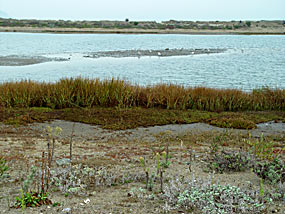 |
 | |
  | |
|
|
|
|
Golden Gate National Recreational Area
Wetlands, Marshes and Swamps
|
|
|
|
|
|
 |
 |
| NPS Photo | | Salt marsh restoration at Crissy Field |
 |
Estuaries provide transition from ocean to land. Freshwater streams meet saltwater tides creating on of the most fertile habitats on earth. Fast growing marsh vegetation provide habitat for decomposers, and the system is based on detritus (decomposed plant materials) rather than live plants. Estuaries also act as a doorway for ocean fish who spawn in freshwater streams such as coho salmon and steelhead trout. For other fish and crabs, estuaries are the perfect place to spawn, leaving the juveniles in the protection of the vegetation and abundant food supply to grow up until they are ready to enter the open ocean. Estuaries also provide important stopovers for migrating ducks and shorebirds as they fly thousands of miles up and down the Pacific Flyway.
The life of marshes is determined by the tides that wash in and out twice daily., They are either submerged by salty water or left high and dry as thee tides recede. Marsh organisms are distributed at different tidal levels, depending on their ability to withstand the stress of tidal inundation. Eelgrass beds grow in channel bottoms and deep basins, supporting sponges, tunicates, and moss animals. Most of these animals are filter feeders or graze on microscopic algae that grow on the leaves of the eel grass. In the mudflats (shallow areas where little vegetation grows), are worms, clams, and snails. Most of these animals are detritivores, filtering organic particles from the water like crabs and shrimp. Raccoons and fox also regularly come down to water’s edge looking for a snack.
Over 90% of the Bay Area’s salt marshes have been developed. Restoration has become a buzzword as more regions of the bay become public lands administered by the Fish and Widlife Service and state and county parks, or nonprofit land trusts. In Golden Gate, Crissy Field is an example of a successful salt marsh restoration project, with many species of invertebrates and fish long gone from the area returnign to the site. Salt marsh vegetation occurs in areas with perennial soil saturation and regular tidal inundation. Adaptations of salt marsh species include mechanisms for salt extrusion, stems that have large air spaces to allow oxygen from the air down to the roots in anoxic soils, and floating seeds. Some species are also succulent to retain water in their tissues. Salt marshes have three distinct elevation zones: 1) the low marsh which is completely submerged daily and dominated by cord grass and pickle weed, 2) the middle marsh which is partially submerged daily and has the highest diversity of species, and 3) the high marsh which is only inundated only during very high tides and dominated by marsh gumplant and marsh rosemary.
|
 |
| NPS photo | | Salt Marsh bird's beak at Crissy Marsh |
 |
The threatened Marsh bird's beak ranges along the central California coast, but due to widescale development of marshlands, numbers have quickly dropped. This small annual was introduced to the recreated salt marsh at Crissy Field in 2001.
The endangeredCalifornia sea blite, although once abundant from Morro Bay up the central California coast, has been extirpated from San Francisco Bay. This small succulent shrub was also introduced to the recreated salt marsh at Crissy Field in 2001.
|
|  |  |

|
 |
|
|
|
|
|
 |
|
Did You Know?
The building now known as the Crissy Field Center originally opened for business in 1939 as a commissary?
|
|
|
|
Last Updated: January 12, 2007 at 14:22 EST |








